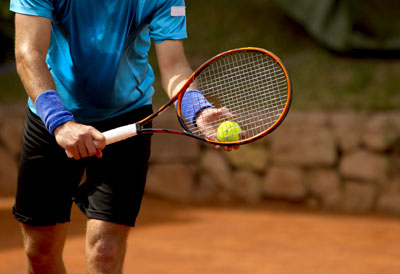
For many of us, warm weather heralds a return to playing tennis or golf and we often jump into these spring activities without proper preparation. In our excitement, we do too much too soon in the pursuit of the perfect tennis match or the perfect round of golf. The end result is nagging elbow pain – either tennis elbow on the outside part of the elbow (i.e., lateral epicondylosis) or golfer’s elbow on the inside part of the elbow (i.e., medial epicondylosis). Both can hamper performance and keep us from the sports we love to play.
Be Proactive to Avoid Common Elbow Injuries!
Playing tennis and/or golf also requires a tremendous amount of flexibility, strength and coordination in the upper body. So, before you pick up your racquet and head to the courts or clean off your golf clubs and head out for a round of golf, you’ll want to follow our four “readiness” tips:
1. Have your MECHANICS evaluated by a teaching professional
Elbow issues arise from forceful wrist or forearm movements that are often a result of compensation in your swing or stroke. Have a professional assess your swing to learn what you can do to improve your form and reduce the risk of injury. Golf incorporates a tremendous amount of hip and trunk flexibility as well as core strength to decrease the stress on the smaller more vulnerable muscles in the wrist and elbow. Because of the complex nature of the swing, a number of swing faults can result in excessive elbow and wrist stress.
Common breaks in Golf Swing form that lead to elbow pain include:
- Hitting the ground, obstruction, excessively fat shots
- Decelerating the club
- Gripping the club too tightly
- Changing/adjusting your grip
- Throwing the club downward rather than pulling through
Tennis requires different shots that rely upon the wrist for spin and control. Evaluation of each type of shot is crucial in understanding how to keep the stress off the wrist and elbow.
Common breaks in Tennis Stroke form that lead to elbow pain include:
- One-handed backhand shot with the shoulder tipped up
- Late forearm swing that bends the hand back to prepare for the ball
- Hitting with excessive spin or snap on the serve
- Excessive bend in the elbow during “cocking” of the serve
2. Get the right EQUIPMENT
Properly fitted equipment can reduce stress on the elbow. Make sure your clubs and racquet are the right length, the racquet and clubs grips are the right size, and the string and shafts have the appropriate tension for your body type.
3. Build your ENDURANCE slowly
Playing 36 holes of golf right out of the box can be a recipe for disaster. Start playing nine holes once a week and add nine holes and one day a week until you are playing as much as you want on a weekly basis. The same advice applies to tennis players. Don’t expect to be able to begin the season with a five set match. Instead, begin with stroke playing and gradually build up to match play.
4. Perform a DYNAMIC WARM UP prior to playing
Dynamic stretching has been shown to be an effective method of warm up and decreases your risk of injury. Walking lunges, trunk twists, and light forward, back, and side to side jogging on the court can help loosen you up for play. Stay away from static stretching because research shows that this type of stretching will actually reduce your power prior to playing.
Warning Signs
If you are experiencing pain and/or joint point tenderness on the inside (golfer’s elbow) or the outside of the elbow (tennis elbow), you may be overusing the muscles in your elbow which over time produces very small tears (micro tears) in the tendon commonly referred to as epicondylosis.
Other symptoms include pain radiating from the elbow to the wrist that is typically worse after activity or weakness of the elbow, wrist, and hand. When proper treatment and care is delayed, healing time can be extremely slow.
Be sure to stay ahead of your symptoms and contact a physical therapist who can assess your condition at the first sign of injury to avoid being kept off the court or off the links this summer.

